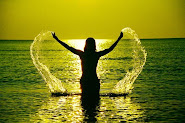 Moksha is the summum bonum of life. It is freedom from births and deaths. It is not annihilation. It is annihilation of this little “I.” It is obtained through Knowledge of the Self. You will have to know the truth through direct intuitive experience.
Moksha is the summum bonum of life. It is freedom from births and deaths. It is not annihilation. It is annihilation of this little “I.” It is obtained through Knowledge of the Self. You will have to know the truth through direct intuitive experience.
You will have to cut asunder the veil of ignorance by meditation on the Self. Then you will shine in your pristine purity and Divine glory. Assert The Majesty Of Your Real Self You are not the little self, Mr. John Murray. You are not Miss. X.Y. Banerjee. You are not Mr. S.R. Iyer. You are not Mrs. A.M. Iyengar. Endeavour to remove this body idea. Attempt to eliminate this sex idea. You are neither a male nor a female.Transmute the sex energy or reproductive energy into spiritual energy or Ojas Sakti by pious thoughts, constant Satsanga, ceaseless Atmic enquiry, study of Atma Jnana books, mental drill and meditation. Remember always, “I am. I exist. I am a centre of consciousness in the ocean of life. I am a centre of thought, influence and power.” Courage, power, strength, wisdom and joy are your divine heritage, your birthright from the Absolute. Develop your will-power. Will has made intellectual and spiritual giants.
You are equal to any and every man. You have emanated from the same source. You are an expression of the same one life, one Existence, one Sat, one Reality. You are the real “I”, the real Atman. You are immortal. You can hardly be destroyed. You are invincible. You can by no means be injured. Belief in this sense-world alone is death. Your real nature is Satchidananda, immortality and bliss. The Seer of Self sees not death nor disease nor sorrow. The Seer sees all as his own Self. He pervades all.
He knows everything. He is all-powerful. What Is Atman? Atman or Brahman is Existence Absolute, Knowledge Absolute, Bliss Absolute. It is different from the gross, subtle and causal bodies. It transcends the five sheaths (Pancha Koshas). It is the witness of the three states: waking, dreaming and deep sleep. It is the support of the twenty-four Tattvas. It is distinct from Jiva and Ishvara who are associated with Avidya and Maya respectively. The Self appears to be finite on account of Avidya. But when the ignorance is dispelled, that one Atman shines by its own light, like the sun when clouds are dispelled.
This Samsara which is filled with love, hatred, etc., is really like a dream. It appears to be all real, so long as one is involved in it, but when one awakes by acquiring true knowledge, it becomes unreal. Just as bubbles rise from, exist and dissolve in the water, so also the Supreme Lord who is the material cause for everything, the pure Atman, by the contact with the five sheaths, etc., appears to put on their respective qualities. Just as we attribute blue colour to the sky, so also we attribute on account of indiscrimination, the qualities and activities of the body and the organs to the pure, Satchidananda Atman.
Passion, desires, happiness, misery, etc., exercise their functions only during waking and dreaming states when the intellect is present and are not present in the deep sleep, when intellect is absent. They, therefore, belong to the intellect and not to the Pure Nirvikara Atman. Egoism and the idea “I know” crop up by indiscriminately mixing up the Satchidananda aspect of Atman with the functions of Buddhi. Vedantic Sadhana Abeginner in Vedanta should study Atma-Bodha, Tattva-Bodha, Laghu Vasudeva-Manana and Vivekachudamani. English translations are available.
He should have a comprehensive understanding of the Vedantic Prakriyas. He should have an intelligent grasp of the three bodies, the five sheaths and their Dharmas or functions, and the three states of consciousness, viz., Jagrat, Svapna and Sushupti. He should know the various Yuktis such as Anvaya Vyatireka, Adhyaropa-apavada, Neti-neti, Laya Chintana, Bhaga-Tyaga Lakshana, etc.
He should have a clear knowledge of Vivarta Vada, Advaita Vada, Drishti-Srishti Vada, Sva-Prakash-Vada and Ajati Vada. An advanced student should study Upanishads, Brahma Sutras, Panchadasi, Vichara Sagar, Naishkarma Siddhi, Chit Sukhi Khandana Khadhyam, Advaita Siddhi, the monumental works on Vedanta. Advanced books should be read under a Brahma-Srotri, Brahma-nishta. He should repeat mentally Pranava (OM) at least 21,600 times daily. He should start his Sadhana, Japa and Nirakara meditation early in the morning at 4 a.m. He should possess the four means of salvation. Meditation 1.
Meditate on the all-pervading air, ether, light, expansive sky, expansive ocean in the beginning to render the mind subtle and fit for abstract meditation. 2. Meditate on abstract virtues, viz., mercy, generosity, magnanimity, courage, patience, peace, balance, poise, etc. Possess these virtues also to the maximum degree. Become an embodiment of these virtues. Have the mental image ‘Om Courage, Om Mercy.’ Repeat these formulae several times daily. 3. Meditate on the following. Take up one formula every month. Repeat the formula several times daily. Vedantic Formulae (a) Nothing exists (names and forms). (b) The world is a long dream.
From Yoga in Daily Life
Lire Les Fleurs "ISBN : 992092784013330
8 years ago






0 comments:
Post a Comment